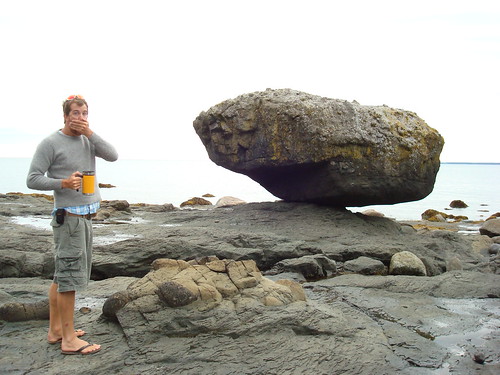Over the course of the past few weeks, I have had a number of conversations with Unplugd participants Tom Fullerton, Andy Forgrave and Stephen Hurley, as well as #ds106radio folks like @drgarcia and @easegill about the nature of the Canadian experience or identity. Spurred on by the inspiration of attending the first “uniquely Canadian educational summit,” the discussion of just what it means to live in Canada, how the landscape influences our national character, and how the immensity of our country factors into the dreaming and expression of its artists, thinkers, and politicians, has continued to fill my thinking. In advance of our author panel coming up this Thursday evening, I thought I would attempt to synthesize some of this thinking and delve into some of my own piece of the Canadian narrative.
Let me debunk an American myth: I take my life in my hands.
Gord Downie
Canada is a big place. And the creation of that mythological Canadian character, that supreme individual in whom resides the imagination of the country is as immense as the space between our scattered cities.
Margaret Atwood has characterized the chief concern of Canadian literature as Survival, and the breadth of citizens living out this central theme in our national life has ranged from the colonists of Susanna Moodie, to artists such as Tom Thompson, and athletes like Sidney Crosby.
These are people with a vision expansive enough to see the whole country, and channel the exaltation of a people bound to one another and their local communities by distance, weather, mountains, plains, and the scattered tribes of NHL franchises, hometown heroes, and brief flirtations with international notoriety. But for the fringes of ‘civilization’ freckled across the 49th parallel, the True North of long nights and longer winters, of hockey played on backyard ponds, and of an intimate awareness of our cohabitation with a visceral wilderness are the everyday experience in the great wide open that separates us all, in our cities or outside of them. And it is against this sparsely populated landscape that the characters and authors of our national narratives lived and recorded their lives in monuments of necessity and invention, art and social artifact.
There exist in great abundance across the country these ‘soul homes,’ where in the unmolested forests from Haida Gwaii or Gros Morne we can touch, and see, and breathe the dawn of not only our Canadian story, but modern human society, and the birthmarks of the very Earth itself. To experience a sunrise against a mountainside bearing the scars of the most ‘recent’ ice age (10,000+ years ago), or swim in a lake scoured into the surface of a two billion year old rock, is to immerse oneself in the immensity of the Canadian experience and imagination. We are greeted daily with the reality that the Edge – of the province, country, ocean or time itself – (if there even is an edge) is well beyond our ability to conceive of it. Oceans rise and fall. Mountains collide, erupt, and crumble. The glaciers come with regularity, and over time our mammalian cousins evolve to live in the sea, then upon land, only to return eventually to the oceans. Life in Canada, from cedar trees, to orca whales and Prime Ministers, is waged against the unavoidable landscape of immeasurable time.
And despite the fact that North America’s First Peoples had managed in this tidal cycle of ice and evolution to live productively – if not in many cases quite comfortably – from coast to coast and north of Hudson’s Bay across the arctic barrens, the European settlers who would write the initial passages in our young nation had left a native landscape that had been subdued by the hands of men and machines for centuries. From landed nobility to indentured servants, Canada’s first settlers had little reason to expect that land, even in the ‘untamed’ New World, would do anything but surrender to the development of crops and the sweep of human progress [1. Of course, they may have also been terrified, scared witless as you or I would be setting out to colonize Mars. But I like to imagine proper French and English gentlefolk encountering the north woods of Ontario with formal-wear and tea sets.]
It is into this terse relationship with the land that Susanna Moodie, and later Tom Thompson, wandered out into their own North Woods and created, in paint and prose, artifact and expression of the energy and life force of the very land itself. And while many did, and many still do cling to the cities [2. Whose character and value I don't begrudge or discount, but aren't the aspect of the Canadian experience I'm after here.], there have always been Alexander MacKenzies, and Emily Carrs, and Terry Foxes, individuals who have pursued in themselves a relationship – a conflict, really: survival, waged against the country’s wilderness, and the limits of understanding our country’s character.
In line with the focus of my #Unplugd11 essay and anecdote, I continue to write the story of our country’s/countries’ unfolding narrative with these individual thoughts, and the perspectives of my friends and colleagues. I am able to continue forward from the summit replenished and inspired by time spent talking, telling stories, singing songs, and forging meaning in the ways people of this place have for millennium: beside lakes and campfires, in canoes, and surrounded by residents of a landscape that has shaped each of us.






















